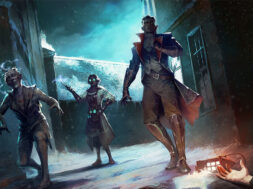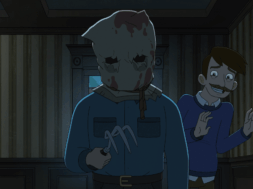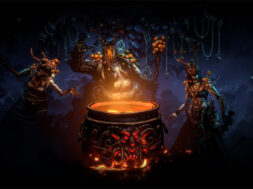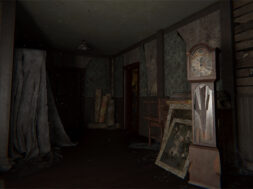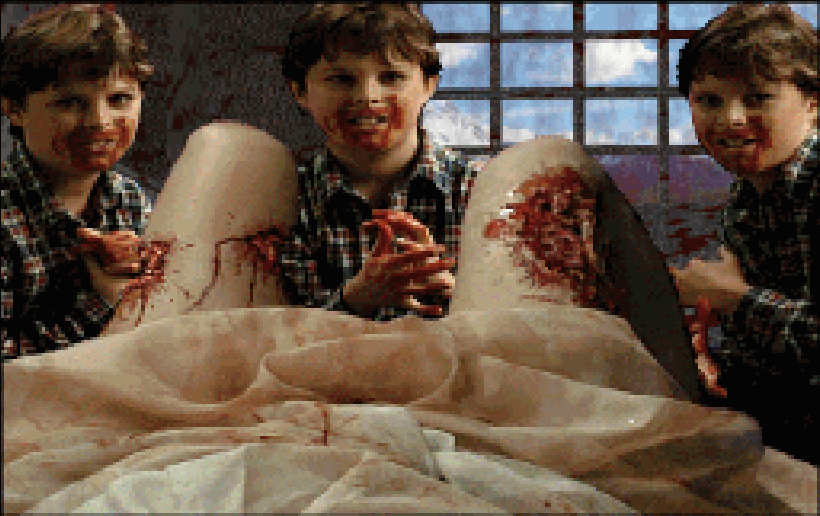
We take a look at the “most violent adventure game of all time” and try to wrap our heads around the game’s bizarre, meta point of view.
“You’ll rot your mind playing games like that. Don’t you know people that watch violence become violent themselves?”
“That’s bullshit, mom.”
Violent, controversial video games are not a new idea. Practically for as long as video games have been around, there has been some title that strives to push boundaries and gets deemed controversial. Through the decades that have followed, there have been notable titles that garner a significant amount of attention, like the Postal or Manhunt series, or even earlier titles like Splatterhouse or Doom that now seem tame by today’s standards. Even franchises that have become normalized to some degree, like Mortal Kombat or Grand Theft Auto, still caused considerable outrages upon release. So while the controversy of violent, over the top games has always been a presence, a game that is often left out of the conversation is the ‘90s PC title, Harvester. Harvester remains an important relic, not only for horror video games, but for the ‘90s as a whole as well as the decade’s relationship with these kinds of games.
Harvester is quite the video game. It’s a game that’s a lot like that kid on the playground who constantly makes up unbelievable stories and always tries to one-up himself. No one asks this kid to continually embellish and go further with their tall tales, but they can’t help themselves from telling more unbelievable stories for attention. Harvester is so over the top in its violence, sex, and taboo impulses that it almost initially feels like a joke. Harvester proudly embraces the fact that it’s one of the most preachy, nihilistic games that you’ll ever come across and that it pushes an extremely heavy-handed narrative that acts as if this game has the ability to change the future of gaming and singlehandedly “solve the problem” of video game violence. The results are a clunky, dated reminder of the times that really just feels more like a joke than anything that could actually inform any change. However, it’s this weird mash-up of tones, sensibilities, and the game’s reception that result in it turning into such an interesting, controversial title that’s still in discussion today.
Rumor has it that Harvester at one point began production as Phantasmagoria 2, and there are definitely similarities between the titles, both in terms of content and production design. Harvester manages to be the stranger of the two titles, which is saying something, because Phantasmagoria is already considerably bonkers. The title comes from DigiFX Interactive, who also did Command Adventures: Starship and the Wolfenstein-esque shooter, The Fortress of Dr. Radiaki. The company eventually folded not long after the release of Harvester. Additionally, the game’s designer, Gilbert P. Austin, had only previously worked on a few Wing Commander games and spin-offs and then The Fortress of Dr. Radiaki. It’s interesting to note that neither Austin nor DigiFX had any horror experience prior to Harvester and that the game would also be Austin’s final game credit. It’s perhaps because of these anomalies that Harvester doesn’t know how to hold back and why it stands out so much.

To speak to the climate of video games at the time, in 1991 the Senator Liebermann hearings had been going on in response to video game violence and its possible dangers. When Harvester was famously announced in 1994 as “the most violent adventure game of all time,” the game almost felt like a cheeky response to the hearings that had been going on. Harvester was announced in ’94, but the game was delayed two years because Austin refused to censor the title in any way (although the game is banned in Germany and the gruesome “Mystery of Motherly Love” scene where a mother’s children cannibalize her—and she enjoys it—is removed from the UK and Australian releases). By the time the game did see release in ’96, similar titles like Phantasmagoria and the Dark Seed games existed, but Harvester has such a strange, unique tone unlike anything else. The only thing that really comes close is the somewhat recent Deadly Premonition and even that’s a generous comparison.
Harvester is that beautiful variety of video game that no longer exists that mostly relies on live-action FMV sequences (with deplorable acting) that were so rampant in the ‘90s. The performances in Harvester aren’t all terrible—although many of them are—but it’s the dialogue here that’s particularly ham-fisted and insufferable. Harvester also decides to fixate on a weird cocktail of topics that covers ‘50s ideals and family values, meat, media violence, and amnesia. At times it often feels like the characters in this game are caught in a parody of both ‘50s sitcoms and ‘90s horror.
The basic premise of the game sees the main character, Steve Mason, wake up in some Stepford-like “Pleasantville” where he has no memory of who he is or the women that he’s supposedly arranged to marry. Furthermore, neither does she, but the rest of the small town carry on like they’re residents of Twin Peaks, as they all speak in hushed whispers, make cryptic references, and speak with an awed reverence towards the town’s centerpiece, “The Lodge.” Steve tries to put together the pieces of not only who he is, but also what’s going on in this community and how he can make it out alive. That’s not a bad premise for a game, but it’s the insane characters and how far the title goes to prove its points that really push all of this to the extreme.

A good portion of Harvester involves fulfilling the Lodge’s strange rituals so Steve can gain admission. The game’s final act in the Lodge shifts from puzzle solving to more action-based killing and puts some arbitrary weapons (scythe, nail gun, shotgun) in play. Steve ostensibly just has to slaughter everyone that he encounters (which includes a blind man) and the game temporarily loses sight of its story. The combat system is pretty clunky and the quality takes a dive here, but it at least makes an attempt for variety. This sort of mix in genres happens in video games all the time now, but it was still a rarity back in ’96. Harvester might be innovative in certain ways, but the real reasons to talk about this game are the ways in which it’s frustrating and terrible. Harvester is a spectacle and it should be treated as such, with wide eyes and slacked jaws as you marvel at the ridiculous scenes that transpire.
Harvester has a lot of quirks, but its relationship with sex is particularly fascinating. Early on in the game, Steve finds his dad’s room bloodied and full of sex toys. The following speech about what a man and a woman do behind closed doors is deeply disturbing too, and Deputy Loomis also shares a heavy obsession with pornography. One puzzle even requires you to distract him with a porno magazine so he can masturbate in a jail cell and by Steve some time. There’s also a particularly disturbing “Good Night Kiss” scene with the sheriff if Steve has a “Get Out of Jail Free” card and gets arrested.

Another “what the fuck” highlight is the sex scene with Stephanie, which is not only pretty ridiculous and graphic for a game of this nature, but it also features her father creepily watching through a hole in the wall, complete with heavy breathing! You can even proposition your own mother for sex if you prompt her with the typed-in response, “Fuck.” It’s surprising how far she’ll respond to the idea. Furthermore, you can die from an STD to in this game, which is a degree of realism that I’m not quite sure is needed, but also something you aren’t going to find in any other game. However, Harvester’s largest obsession is the hefty number of obscene dick jokes hidden in the scenery and item descriptions (“There’s the man of the house, squeezing his meat”). Even the game’s menu and save screens are creepy and unnerving.
The game’s unusual relationship with sex is one thing, but Harvester exhibits other strange impulses that feel like they’d be out of place in any video game. One tense sequence involves Steve talking to a military general who’s in charge of nuclear missiles and just so happens to be missing his legs and half of his torso from WWII injuries. In this situation, if you respond to the general with “Comrade” in your answer, he’ll viciously shoot you in the head and launch the nuclear missiles on Russia. It’s absolutely bonkers, but where else will you see something as ridiculous as this in a video game? Harvester also turns the community’s fire department into a running “joke” about homosexuality. Each firefighter is an offensive stereotype who all spend their days sketching nude models in the fire department, which they call “The House of Flame.” Even their fire trucks are pink instead of red.

Harvester begins in a very leisurely way and the start of the game is more interested in establishing the title’s mystery and mood while making sure that the player is sufficiently uncomfortable before the real gruesome survival horror aspects kick in. An atypical, saccharine sweet score helps make the experience feel even creepier. In spite of its B-movie tendencies, Harvester does get under your skin and at first you really have no idea where this story is heading. This is particularly rare for a video game from the ‘90s and it helps add to its uneasy direction.
The other big element in Harvester is the degree of moral responsibility that the game pushes on the player. Decades later these sorts of heady decisions would eventually become fundamental in titles like Fable or BioShock (although it’s also a crucial component in fellow ‘90s horror oddball title, I Have No Mouth and I Must Scream). If players decide to make Steve take actions like punch the paperboy, then they’ll see their protagonist get shot dead in his tracks. It becomes clear fairly quickly that it’s in your best interest to be a “good citizen,” lest you end up in the electric chair, or worse.
These moral quandaries and Harvester’s violent set pieces are the focal point of the title and it’s shocking to see just how far this game is willing to push its dark impulses. There’s a disturbing segment set within a school where a teacher beats a child in the face with a baseball bat when he questions her “duck and cover” air raid advice. The gamer is constantly put in situations where they must decide whether they want to hurt others, or get hurt themselves. Another dead end will see Steve’s allies, Stephanie and Karin, both hang themselves at the diner in a very bleak, depressing reveal.

Not even babies are safe in Harvester, which becomes clear after a particularly rough baby torture scene where the infant gets fed tarantula eggs, proceeds to become infested by wasps, and then has her eyes pop out. It is…a lot. It’s such pure nightmare fuel that it’s surprising that this scene wasn’t also removed from the UK release. When scenes like this show up in Harvester it’s hard not to think that the game is intentionally trying to be funny and play into the B-movie angle. Harvester turns things up to 11 and then breaks off the dial whenever possible. In one scene, Stephanie’s spine is gruesomely ripped out while the investigating police officer noisily chomps on pie at the crime scene. Furthermore, he declares this death to be by “natural causes.” Um, her freaking spine is ripped out!! “You can’t live without a spinal cord,” he says. “Nothing unnatural about that.” Another controversial scene sees a female character deal with body issues. She declares herself fat when she looks at herself in the mirror and then proceeds to claw the skin off of her face. Relieved, she exclaims, “Look at my complexion. Pale, white, and gleaming.”
Harvester pulls out all of the stops for its grand finale, which expertly tows the line between brilliant and abysmal, but certainly leans more into the latter. The game reveals that Steve’s entire experience has all been a VR simulation that’s designed to figure out if a serial killer can be programmed or “built.” In the game, the “Harvest” is the simulation, but for the gamer, the simulation is Harvester itself. Steve is shown to actually be playing Harvester and that this is what breaks him. This narrative supports the idea that a game like this (or an innocuous roadrunner cartoon) is no different than a murder simulator. This is all supposed to function as a powerful shocker of an ending—and in some ways it is—but the greater message behind it is so ridiculous that it’s very hard to take any of this seriously. Furthermore, the point here is to attack violent games after making someone play “the most violent game of all time”? By that logic Harvester has created a bunch of desensitized serial killers in-the-making and this ending just rubs that damage in your face.
This is all meant to function as a thorough satire of ‘90s video games and how much of the public believed that games would turn into “murder simulators” for impressionable youth. Harvester even features explicit references to Doom and Mortal Kombat (in a “Finish Her” spine-ripping fatality, no less) to make this theme as apparent as possible. The game’s concluding lines even feature this very pointed exchange: “You’ll rot your mind playing games like that. Don’t you know people that watch violence become violent themselves?” “That’s bullshit, mom.”

Alternatively, Harvester’s “Good Ending” isn’t much better. Here you choose to not kill Stephanie, but instead spend the rest of your “happy” life in a virtual reality simulation. You get your happily ever after, but it’s all a lie and you’re actually just a failed experiment. You don’t become the serial killer that is born from the alternate bad ending, but the message that video games (or “good breeding,” as this ending creepily suggests) are the way to create a serial killer is still present, even if the results are different.
Harvester raises some big questions with its finale, but it didn’t save the game from a fairly mixed, unflattering opinion of the game back in 1996. However, fans of Harvester were passionate about the unusual title and it would go on to gain a cult status over time. Now, twenty years after its initial release, Harvester is arguably more popular than ever before. There’s even a Harvester YouTube series that digs even deeper into every aspect of the game’s production and is a testament to the strange community and fandom that the game has cultivated through the years. A computer game like Myst is no doubt more successful than Harvester, but is Myst still getting this in-depth treatment and having contemporary discussions about how it all came together? Against all odds, Harvester has proven that it can withhold the test of time…and good taste.
Or maybe we’re all just stuck in virtual reality simulations and are just waiting to be woken up from the latest Harvest.
‘Harvester’ is available to play on GOG.com as well as Steam…at your own risk.

